All 25 entries tagged Undergraduate Research
No other Warwick Blogs use the tag Undergraduate Research on entries | View entries tagged Undergraduate Research at Technorati | There are no images tagged Undergraduate Research on this blog
January 01, 2021
Glorification and personification on the Judaea Capta coinage
When Titus captured Jerusalem and destroyed the Second Temple in 70 AD, the triumph awarded to him and his father Vespasian was swathed in luxury and decadence. This was a victory that celebrated the violent result of years of strained relations between Jerusalem and Roman governance. The taking of Jerusalem involved a long and bloody siege resulting in the deaths of a reported 1.1 million people, most of whom where Jewish (Josephus, Jewish Wars 6.9.3). Those who survived were paraded through the streets of Rome, and the spoils of war contributed to the building of the iconic Flavian amphitheatre we know as the Colosseum.
The Roman victory, as so often was the case, was advertised upon the contemporary coinage. As travelling propaganda, these coins reinforced the idea of Roman supremacy and the might of the empire. The Judaea Capta type was minted in various denominations in the name of Vespasian and both of his sons, and in spite of several variations in design the overall message remained the same.
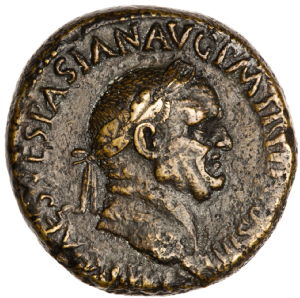 |
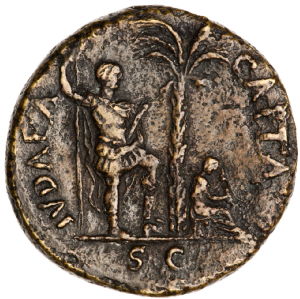 |
Sesterius of Vespasian, AD 71, RIC II.12 167, reproduced courtesy of the American Numismatic Society (inv. no.0000.999.18073).
The legend on the reverse states IVDEA CAPTA ,‘Judaea conquered’, and the coin depicts a woman seated beneath a palm tree, with a man, interpreted as the emperor, watching. The woman is Jerusalem, her hand to her cheek in a traditional expression of mourning. She is wearing civilian dress, and reflects the prophecy of Isaiah 3.26: ‘…And her gates shall lament and mourn, and she being desolate shall sit upon the ground’ (Young (1992) 170). By contrast, the male watching is standing, and still wears his armour, his foot placed on a helmet. The palm tree sets the scene of the victory in Judaea.
Personification was often used by Rome to reflect victory, as it expresses an effective message that was simple to comprehend. In this case, the use of opposing characteristics of the figures on the coins is extremely powerful in conveying the intended message. Jerusalem is depicted as female, and therefore as weak and submissive in contrast to the male figure representing Rome. The male figure, often interpreted as Vespasian himself, stands in reference to his elevated position over the woman in his victory. Where the woman is unarmed, the man is still dressed for battle in a reflection of victory
Other versions of this coin replace the armoured man with a winged Victory, or sometimes a bearded man with his hands tied behind his back. The latter is a depiction of a soldier of Jerusalem, bearded to reflect his ‘barbarian’ status in the eyes of the Roman Empire. His weapons and armour are laid down beside him in an image of defeat (RIC II.1² Vespasian 159). The legend also has variations, such as IVDAEA DEVICTA, ‘Judaea defeated’ (RIC II.1² Vespasian 1120), or DE IVDAEIS ‘[the booty] from the Judaeans’ (RIC II.12 1179) in reference to the wealth stolen from the temple of Jerusalem. The palm tree has been interpreted as a representation of Rome victorious over Judaea.
The coin is one of many examples of media expressing the Flavian victory over the province of Judaea, including the arch of Titus which still stands proudly at the entrance to the Roman forum today. In a passing glance it appears as just another Roman victory arch, but if you take a closer look you can spot iconography relating to the siege, including a parade of people carrying aloft a menorah from the temple.
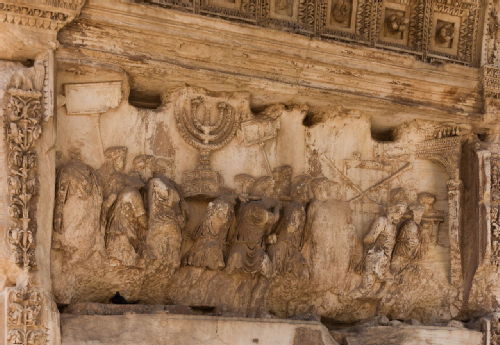
Close-up of the menorah being carried in the victory parade on the Arch of Titus .Image from WikimediaImages from Pixabay.
The Judaea Capta coinage reflects an important moment in the history of Rome, and likewise the history of Jerusalem. The Great Revolt resulted in a mass of deaths, displacement and enslavement. The minting of Judaea Capta coinage therefore becomes part of the Roman narrative of glorified victory and imperialism in the Flavian period.
 |
This month's entry was written by Rebecca Preedy. Rebecca is an Ancient History and Classical Archaeology with Study Abroad student. She is completing her final year at Warwick after a year abroad at La Sapienza. Since studying in Rome, Rebecca has been fascinated by the ancient city and is hoping to continue her studies with a postgraduate degree in Roman Material Culture.
Select Bibliography
• Josephus, The Jewish War, trans. G. Williamson (London: Penguin)
• The Holy Bible: King James Version (Massachusetts: Hendrickson 2004)
• Carradice, I. (2012) ‘Flavian Coinage’ in The Oxford Handbook of Greek and Roman Coinage ed. W.E. Metcalfe
• Claridge, A. (2010) Rome: An Oxford Archaeological Guide (Oxford: University of Oxford Press)
• Moresino-Zipper, A. (2009) ‘Die Judaea-Capta-Münze und das Motiv der Palme. Römisches Siegessymbol oder Repräsentation Judäas?’ in Jerusalem und die Länder: Ikonographie - Topographie - Theologie eds. A. Moresino-Zipper, G. Theißen, H.U. Steymans, K.M. Schmidt, S. Ostermann
• Stevenson, T.R. (2010) ‘Personifications on the coinage of Vespasian (AD 69-79)’ Acta Classica 53:181-205
• Young, E.J. (1992) The Book of Isaiah (Michigan: William B. Eerdmans Publishing Company)
December 01, 2019
The crocodile as a symbol of Egypt on a victory coin of Augustus
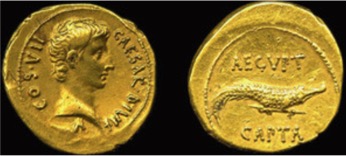 |
Gold Aureus from 27BC (RIC 12, P.86, no. 544) The obverse depicts head of Augustus with ‘CAESAR.DIVI.F.COS.VII’ inscribed. On the reverse is a crocodile facing right, representing Egypt. The reverse legend reads ‘AEGVPT CAPTA.’ Image produced courtesy of the Trustees of the British Museum.
After a tense period of civil war, Octavian’s decisive victory at the Battle of Actium in 31BC left Marc Antony with insufficient military support to win the war, and a year later Egypt was conquered and absorbed into the Roman Empire. Marc Antony and Cleopatra committed suicide, leaving Octavian as the unrivalled, sole ruler of the Roman world, a victory he was keen to advertise. The above pictured coin is a gold aureus celebrating the acquisition of Egypt. It is typical of victory coinage, with the obverse depicting a portrait bust of the ruler (who was the victor), in this case Octavian, and the reverse depicting an image symbolic of the conquered nation, in this case a crocodile. The gold aureus is similar to a near identical issue of silver denarii struck in the previous year. Both coins hailed Octavian as son of the divine Julius Caesar, establishing his legitimacy on a political and religious level.
That Octavian chose the image of a crocodile to place on the reverse of his coins is of particular interest. First and foremost, it presents Octavian as the victor over a foreign enemy. Crocodiles were popular in Roman art as images representing foreign and exotic ideals, and their use here was no doubt intended to draw attention to the war in its international context, and thus overshadow the morally dubious truth of it being, in truth, a civil war. Octavian was now the sole ruler of Rome, having violently deposed of his co-consul. It was therefore crucial for him to deter any criticism and suggestions of tyranny. The crocodile was a particularly suitable image because of its associations with danger, and thus it had the added benefit of presenting Marc Antony as a threat to Rome. This helped to authorise Octavian’s war against his fellow Roman, and once-ally, and aligns with much of Octavian’s earlier propagandist campaign against him. The crocodile therefore helps to reinforce the idea that Octavian should be hailed, not as the violent murderer of his co-consul, but as the saviour of the Roman Empire.
 |
Coin of Crassus showing a crocodile. Image produced courtesy of the Classical Numismatic Group.
This is not the first time a crocodile had been used in Roman coinage. Already in 37BC, the crocodile had appeared on the coinage of a figure largely identified as M. Licinius Crassus, son of the triumvir Crassus. It is believed that this coin celebrated Roman territory ceded to Cleopatra VII of Egypt by Marc Antony. It is interesting therefore, that this same symbol of Egypt should be used by Augustus only ten years later to celebrate the exact opposite: the conquering of Egyptian territory by Rome. On the coin of Crassus, it is likely that the crocodile was chosen because of its associations with the Nile, which itself was associated with the agricultural wealth of Egypt. We can therefore infer that this earlier use of the image of the crocodile was intended to celebrate Egypt in a gesture of diplomacy. Octavian, aware of this, may well have deliberately used this same image, already known for its associations with agricultural wealth, in order to boast of his achievement at having acquired such an important nation into the Roman Empire. Rome relied heavily on Egypt for its imports of grain, and hence Octavian’s victory was of crucial importance. It is likely the coin instilled pride in its Roman viewers, for belonging to such a large, powerful empire.
As we have seen therefore, the coin presents Octavian as a successful military leader, who not only saved, but also contributed to the Roman Empire. It also served to justify his recent war against Marc Antony by presenting it as a foreign conquest. We can see that the imagery was carefully chosen in order to secure and validate Octavian’s position as sole ruler of Rome.
 |
This month's entry was written by Richa Snell. Richa is a final year classical civilization student with an interest in material culture and iconography, which she is hoping to pursue further by studying for a master’s degree next year. She is currently writing her undergraduate dissertation on imperial uses of Egyptian imagery.
Bibliography
R.A. Gurval (1995) Actium and Augustus: The Politics and Emotions of Civil War (Ann Arbor: University of Michigan Press).
C.E. Barrett (2017) ‘Egypt in Roman Visual and Material Culture’ in Oxford Handbooks Online in Classics Studies, ed. G. Williams (Oxford; New York: Oxford University Press).
M.Swetnam-Burland (2015) Egypt in Italy: Visions of Egypt in Roman Imperial Culture (Cambridge: Cambridge University Press).
D. Vagi, Crocodiles on Roman coins familiar as the emblem of Egypt – https://www.coinworld.com/news/precious-metals/crocodiles-on-roman-coins-familiar-as-the-emblem-of-egyptian-province.html (15 Feb 2015). Accessed 31 Oct 2019.
September 01, 2019
Achaean League Coinage and Collective Identity
On the Greek mainland in the Hellenistic Period, some of the city states united into federal leagues, the most successful of these being the Achaean League. In my undergraduate dissertation I wanted to show how the Achaean League developed its collective identity and how this affected the policy and the society of the League. Collective identity is how states and individuals can identify with both their home city and the overarching political body (i.e. a modern example is me saying I am both European and British). The coinage of the Achaean League acted as a means of spreading this message throughout the League. In this blogpost, I’m going to show how the coinage reflected the policy of collective identity. To examine this topic in depth I’m going to examine a coin from Megara and how the Megarians reconciled the ‘Dorian’ and ‘Achaean’ aspects of their identity.
Types of Achaean Coinage
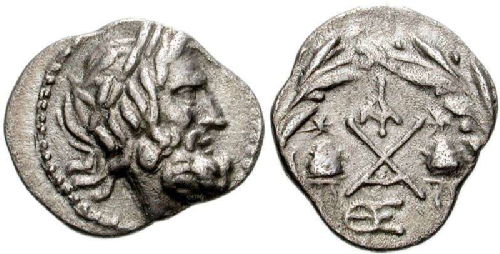 |
Achaean Hemidrachm, minted at Sparta, with symbol of Dioscuri caps and abbreviation of LA on the reverse, and head of Zeus Homarius on the obverse.
Polybius proudly states that the Achaeans “formed the states into a community of allies and friends, but they have also adopted the same laws, weights and measures and coinage…” (Polybius, Histories, 2.37). This has been interpreted as a way of showing “the social and political solidarity of the second-century Peloponnese.” (Thonemann (2015) 72). These coins were silver hemidrachms, worth half a drachm, and were minted in nineteen different poleis of the Achaean League. Each of these cities produced the coins to a similar blueprint: a head of Zeus Homarius on the obverse, and a monogram of the word Achaean on the reverse. The different mints are indicated with either abbreviations or with symbols, such as the Pegasus of Corinth.
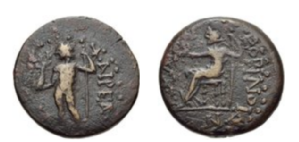 |
Achaean tetrachalkon, minted at Corinth, Obverse: Zeus with sceptre and holding Nike in his hand. Reverse: Seated figure of the personified Achaea. Both motifs were common throughout the Hellenistic World.
These ethnics and symbols helped to bind the cities to the league by associating them with the federal Achaean body and making them as one and the same, whilst celebrating the individual characters of the cities themselves; it shows dedication to the federal ideal. This is further proved by the bronze coinage of the league, which was struck in over forty-five out of the seventy odd cities in the league. These small poleis were committed to the league and were willing to invest heavily in that relationship. Warren suggests that over 1600 dies were used in the minting of these bronze coins, which is an extremely heavy investment, especially compared to how other poleis minted coins in the Hellenistic Period (Warren (2007); Thonemann (2015) 74).
Maintaining local identity in a federal state
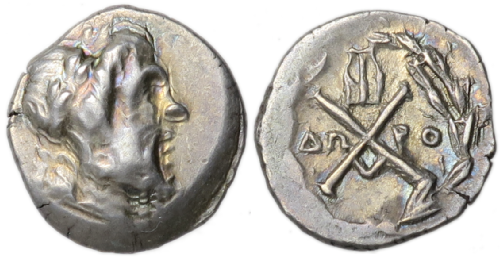 |
Achaean Hemidrachm, minted at Megara. Obverse: Head of Zeus Homarius. Reverse: Achaean League monogram and abbreviation of word Dorian.
The collective identity of the Achaean League didn’t mean that various local identities were weakened. In fact, the network of poleis meant that they strengthened their local identities, and the environment of competition between the constituent members changed. Coinage was one media that expressed this.
This coin from Megara helps to show the nuance that went into how the ancient Greeks identified themselves. Across the Achaean monogram is the abbreviated ethnic, but rather than denoting the city of Megara, it draws attention to the Greek ethnic group of the Dorians. The Egyptologist Lynn Meskell has said that “identity is what is draped over a person by the groups of which he or she is part” ((1999) 32), indicating that identity is multi-faceted and complex, consisting of many layers. The complicated layers of this coin show that the people of Megara want to advertise their history as Dorians, and the political reality of their position as members of the Achaean League. One did not trump the other, and from the view of inter-polis competition, the historical baggage of the term will have had an effect on how Megara was received within the league.
Conclusion
This examination of Achaean coinage has shown how integrated the society of the Achaeans was, and that whilst Polybius’ assertion that the Peloponnese was a “single state” (2.37) is apt, the situation was a lot more complicated. Each member state had its own agenda and history, but worked under the umbrella of Achaean identity in order to be stronger and more efficient (Close (2018)). The coinage of the various states of the Peloponnese show how these states were able to reconcile the identities that both united them and showcased their uniqueness.
Bibliography
Primary
Polybius, Histories, trans. Waterfield, R. Oxford University Press: Oxford 2010.
Secondary
Close, E. “Megalopolis and the Achaean Koinon: Local Identity and the Federal State.” Teiresias 48.1 2018: 2–8.
Meskell, L. 1999. Archaeologies of Social Life. Oxford: Blackwell Publishing Ltd.
Thonemann, P. 2015. The Hellenistic World: Using Coins as Sources. Cambridge University Press: Cambridge.
Warren, J. 2007. The Bronze Coinage of the Achaion Koinon: the Currency of a Federal Ideal. London: Royal Numismatic Society.
 |
This month’s entry was written by Jameson Minto, who recently graduated from Warwick. His dissertation was titled ‘The Achaean League and Collective Identity’ and dealt with the evolution of both the institutions of the league and the creation of the Achaean identity. Jameson runs his own blog, Musings of Clio, which discusses the ancient world, and he is set to study an MA in Classics and Ancient History at the University of Manchester.
August 01, 2019
From divinity to the Duce: the many meanings of the Julian Star
 |
|
Augustus, Caesaraugusta (possibly), Spain, denarius, 19-18 BC.
RIC 1 37b, pg.44 (British Museum, R.6067).
Obverse: CAESAR AVGVSTVS; head of Augustus, wearing oak-wreath, left.
Reverse: DIVVS IVLIVS; comet with eight rays and tail upwards.
|
During Julius Caesar’s memorial games in 44 BC, a great comet allegedly appeared. Pliny the Elder writing in the 1st century AD quoted Augustus describing the comet:
On the very days of my games a comet was visible for seven days in the northern part of the sky. It was rising about an hour before sunset, and was a bright star, visible from all lands.
Pliny the Elder, Natural History 2.94
Today this comet, mainly known as the Julian Star or Caesar’s Comet, is one of the most famous comets in classical antiquity, despite there being little contemporary evidence to support its existence (see Ramsey and Licht, 1997). The image of this comet and other solar imagery featured throughout Augustus’ rule during 27 BC- 14 AD. Indeed, by the time of the Flavians in the late 1st century AD, solar symbolism in general “had become part of the imperial cult”, such was its importance (Weinstock, 1971, 384). The comet was also so influential that the fascist Italian dictator (who ruled from 1919-1943) Benito Mussolini included this image on a stamp to commemorate Augustus. Why did this symbol become so important, and what made it so resonant that someone more than 2,000 years later would choose to use it?
Firstly, we should take into consideration the symbolism of the star in the years before Augustus. Julius Caesar, Augustus’ adoptive father, initially put stars on his coinage in the years before his death in 44 BC (e.g. RRC 480/5a). The symbol of a star or comet had both positive and negative connotations around this time, being able to symbolize amongst other things “the divine or deified ruler”, yet also portend evil (Weinstock 1971, 378, 371). Whilst still alive Caesar may have only wanted to signify his descent from Venus with the star on coinage, but after his death it took on a new meaning. The common people interpreted the comet of 44 BC as a sign that Caesar had been received in heaven, which then helped push the star symbol as confirmation of Caesar’s divinity (Pliny, Natural History 2.94). Augustus further built upon this symbolism when he added a star on top of a bust of Caesar in the forum to mark the comet, and dedicated a temple to the deified Caesar (Suetonius, the deified Julius 88).
By using this symbol in his own coinage, Augustus could also make subtle connections between his own reign, the comet, star imagery and the divinity of Caesar (Williams 2003, 7). The symbol is a prime example of Augustus’ technique of “carefully nuanced suggestiveness” which he so often used in his reign (Galinsky 1996, 312). By associating himself with a symbol that was tied to Caesar’s image, Augustus was asserting his familial connection, while allowing further associations with divinity to also exist.
 |
|
Augustus, M. Sanquinius, Rome, denarius, 17 BC,
RIC 1 340, p.66, (British Museum, 2002,0102.4960).
Obverse: AVGVST DIVI F LVDOS SAE, herald, in long robe
and feathered helmet, standing left, holding winged caduceus in
right hand and round shield with six-pointed star, in left hand.
Reverse: M SA[NQVI]NIVS III VIR, head of deified Julius Caesar,
laureate, right; above, comet with four rays and a tail.
|
Further symbolism was associated with the comet during the Saecular Games of 17 BC, which celebrated the start of a new age. To commemorate the games, the moneyer M. Sanquinius issued a coin series again featuring a comet, but within the context of these games, with the name of them inscribed on the coin obverse (LVDOS SAE). This coin may have been intended to highlight the prophecy made by the Haruspex Vulcanius, who proclaimed the 44 BC comet to herald a new age (Weinstock, 1971 195). Thus perhaps as well as power and ancestry, the comet came to resonate as a symbol of Augustus’ “Golden Age” as a whole.
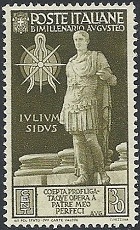 |
|
30 cent stamp with the
quote from Augustus’
Res Gestae.
|
By the 20th century, Augustus and his regime seem to have become a figure of world-renown; a 1937 exhibition at the Metropolitan Museum of Art called Augustus “one of the few statesmen who belong not to one country or to one continent but to the whole world” (Richter, 1938 272-273). Mussolini seemed to realise Augustus’ potential as a figurehead for fascism, as during the 1930s Augustus featured frequently in Italian propaganda. The bimillenium of Augustus’ birth was celebrated during 1937-8 and a stamp series commissioned in 1937, one of which featured the comet. Unlike Augustus’ coinage, which circulated within the bounds of an empire, these stamps were a possible means by which Italy as a newly fascist nation could broadcast its symbolism, both nationally and internationally (Reid, 1984 226). On this stamp this comet had come to represent Augustus as a whole with its position beside both a statue of Augustus and excerpt from his Res Gestae. The comet had transformed from a single phenomenon to a symbol synonymous with imperial power.
Primary Sources:
Pliny the Elder, Natural History volume I book II trans. H. Rackham (Harvard University Press: Cambridge, M.A. 1938)
Suetonius, Lives of the Caesars volume I: The deified Julius 88 trans. J. C. Rolfe (Harvard University Press: Cambridge, M.A. 1914).
Richter (1938) “The Exhibition of Augustan Art”, The Metropolitan Museum of Art Bulletin Vol. 33, No. 12, pg. 257,272-279.
 |
This month's coin of the month was written by Daisy Ashton. Daisy recently completed her BA in Ancient History and Classical Archaeology at the University of Warwick. She is interested in the ancient world's impact on modern heritage, and is going on to do an MPhil in Heritage Studies at the University of Cambridge.
May 01, 2019
Greek by name, Indian by nature: Indo–Greek Coinage
 |
|
Bactria: Agathocles. 180-165 BCE. Copper alloy. BMC 1844,0909.61
Obverse: Brahmi legend. Female deity.
Reverse: Greek legend. Maneless lion.
|
If I told you this was a Greek coin would you believe it? The writing on the obverse is decisively not Greek; the square shape is certainly not what we are used to in Greek coinage, and the female deity on the obverse doesn’t look like anybody in the Greek Pantheon. The only clue we get to this coin’s ‘Greek’ origin is the Greek legend on the reverse, which reads ‘BAΣIΛEΩΣ AΓAΘOKΛEOYΣ’, translated as ‘King Agathocles’. It is an Indo-Greek coin, minted in this way for a very specific political purpose: to try and assimilate the Greek king with his Indian subjects.
To understand how a coin like this can be produced, we must start by understanding its geo-political context. It was minted in Bactria (the area that comprises modern day Afghanistan, Tajikistan, Northern Pakistan and Uzbekistan) in the 2nd century BCE by the Indo-Greek king Agathocles. Bactria, by the 2nd century, had already established itself as a real mixing pot of Greek, Afghan, and Indian culture. The region was first exposed to Greek culture after Alexander the Great conquered the territory in the 320’s BCE. Then Seleucus I (a Greek successor to Alexander, one of the Diadochi) established himself as ruler in Asia and his dynasty retained power for another century, further reinforcing the Greek influence in the area. Bactria gained independence between 250-240 BCE, and the Greek Diodotus I became the first Greco-Bactrian king. In the 180’s Greco-Bactrian kings, notably Demetrius I and Menander, started to conquer parts of northern India. Consequently, scholars refer to the kings who ruled this new territory, comprising parts of India, as the Indo-Greek kings. It was in this context that Agathocles, the king who minted the coin in discussion, was operating.
Almost every aspect of this “unusual” coin serves Agathocles’ political purpose. “Unusual” is in inverted commas, as, in fact, Agathocles was following an extremely common trend. It just wasn’t a Greek trend. The kings of the Indian Mauryan dynasty who ruled from the 4th to the 2nd centuries BCE minted almost exclusively square coins. The script on the coin is called Brahmi, the script in which the local Indian language, Pakrit, was written. The legend reads ‘King Agathocles’ in Brahmi script (Rajane Agathuklayasa). Not only was Pakrit the language of the locals, it was also the language of Buddhism, and Agathocles put this script on his coinage to show a genuine attempt at assimilation of Greek and Indian culture.
The images on both sides of the coin also evoke Indian culture. The female deity on the obverse is believed to be Subhadra, the sister of Krishna. The animal on the reverse is agreed to be a ‘maneless lion’, and refers to the literal meaning of Agathocles’ brother’s name: Pantaleon. It was Mauryan custom to use symbols or images to refer to oneself, rather than simply put a portrait on the coins as the Greeks usually did, again, part of Agathocles’ agenda to blur the lines between Greek and Indian culture.
Coins such as these cause us to pause and think: what does ‘Greek’ mean? Does it mean the presence of the Greek language? Minted by a Greek? Because this coin certainly has those aspects. However, this coin would stick out like a sore thumb in a collection of ‘traditionally Greek’ coins. It reveals that in this part of the world, the definitions between Greek and Indian are not so clearly cut. Would an Indian local see this as a Greek imitation of something they had been used to, or would they see it and think there is nothing out of the ordinary, apart from a few (Greek) letters they didn’t understand? These are questions that I am unable to answer here, but that are important to consider when drawing the boundaries between ‘Greek’ and ‘non-Greek’.
 |
This month’s entry was written by Tunrayo Olaoshun, a 4th year undergraduate of Ancient History. She developed a further interest in numismatics during her year abroad in Bologna. Her main interests lie in the later Roman Empire.
Select bibliography:
Avari, B. (2016). India: the ancient past: a history of the Indian subcontinent from c. 7000 BCE to CE 1200. (London, New York: Routledge)
Narain, A. (1989). The Greeks of Bactria and India. In A. Astin, F. Walbank, M. Frederiksen, & R. Ogilvie (Eds.), The Cambridge Ancient History. (Cambridge: Cambridge University Press).
Tarn, W. W. (2010) The Greeks in Bactria and India. Cambridge: Cambridge University Press (Cambridge Library Collection - Classics).
December 01, 2018
An Unusual Victory Coin

RIC II Trajan 557. Image reproduced courtesy of the Trustees of the British Museum.
The practice of issuing a victory coin after the conquest of a new territory was frequent in ancient Rome and it was a practice with a long tradition. In most instances what is depicted on the coins is either a scene in which a representation of the defeated country is mourning (cf. Iudeea capta, RIC II, Part 1 (second edition) Vespasian 161), or a symbol of the defeated country (cf. Aegypto capta, RIC I (second edition) Augustus 275A). However, one of the coins issued by Trajan after the conquest of Dacia is very different.
This coin is a sestertius dated between AD 103 and AD 111, issued in Rome, and now kept in the British Museum. On the obverse of the coin we find the bust of Trajan, laureate, facing right, with the text ‘IMP CAES NERVAE TRAIANO AVG GER DAC P M TR P COS V P P’- Trajan’s name and titles in the dative. On the reverse is a combat scene in which the river Tiber pushes Dacia to the ground with his right knee. The violence and the dynamism of this image is unusual for a Roman coin and I will present my hypothesis for this matter in this article.
This coin was issued to celebrate the Trajan’s victories over the Dacians. In AD 101, Trajan crossed the Danube and attacked Dacia despide the treaty that his predecesor Domitian had made with the Dacians. Another war followed in AD 106 after which most of Dacia became a Roman province.
The exact causes are controversial because of the lack of contemporary sources, but Dio’s text suggests that it was a punitive war. Regardless if this is true or not, it is clear that Trajan wanted to display this image and maybe show through this image that the nations willing to attack Rome would be defeated in battle.
The fact that it is the personification of the Tiber, a river, that is shown defeating Dacia is very interesting. On Trajan’s column, which depicts his wars against the Dacians, there is another personification of a river: the Danube. As the coin circulated over time, a viewer who had seen the column once it was completed in AD 113 might recall its scenery and the battle scenes depicted upon the monument. On the column the Danube is represented helping the Roman army.
This was the first Roman conquest in fifty years and it is possible that Trajan wanted to show it in a memorable way. To do this he chose to use this vivid violent scene to impress the people who would see it and to suggest that more territories would be conquered: in 114 and 115 he would also annex Armenia.
So, I think that the fact that Trajan wanted to show the people what happened if a people were to challenge Rome may have contributed to the creation of this unusual victory coin.
 |
This month's entry was written by Luiza Diaconescu, a third year undergraduate student in Classical Civilisation. Luiza is very interested in Roman history and literature.
Select Bibliography:
Bellinger, A & Berlincourt, M (1962) ‘Victory as a coin type’, Numismatic Notes and Monographs 149:1-68
Bennett, J. (2001) Trajan: Optimus Princeps (Bloomington: Indiana University Press)
July 01, 2018
Augustus and the Exaggeration of Military Victories

Figure 1: Figure 1: Gold Aureus from the reign of Augustus, 19-18 BC (RIC I (second edition) Augustus 514). The obverse depicts the head of Augustus, with ‘AVGUSTVS’ inscribed (not visible on this specimen). On the reverse is the deity Victory cutting the throat of a bull, representing Armenia. The reverse legend reads ‘ARMENIA CAPTA’. Image produced courtesy of the Trustees of the British Museum.
This coin is indicative of Augustan propaganda, where Augustus exaggerates the role of the military in dealings with Armenia. The Roman Empire and the Parthian Empire were in constant dispute over Armenia, which acted as a buffer zone between the two empires in the East in the first century BC. Armenia fell under Roman influence as a result of treaties and the installation of a pro-Roman ruler, not military annexation. Thus the portrayal of the deity Victory slaughtering a bull (presumably representing Armenia) paints a false militarised narrative of events. The question is why Augustus, on this aureus dating from 19-18 BC, would want to exaggerate his dealings with the Armenians.
It is my belief that this false depiction is an attempt by Augustus to link himself with the military and military success, both key factors in obtaining popularity and support in Ancient Rome. Augustus tries to ‘piggyback’ off the popularity of the army in order to consolidate power; he wishes to be seen as a military man in an attempt to secure his longevity. The military’s popularity stems from the role they played in achieving and maintaining the Empire alongside their connection to the beginnings of Rome, explored by Virgil’s Aeneid. Augustus’ own position was extremely fragile due to the unprecedented nature of his Principate and the real threat of civil war occurring again; he thus sought avenues of popular support. The term ‘capta’ indicates military success, suggesting that the entire state was captured and subjugated, yet this is wholly false. Augustus later on in his own autobiography, Res Gestae (27), even admits this, stating ‘though I might have made it a province’ and details installing a Pro-Roman ruler, further highlighting the degree of exaggeration on the aureus.
The history between Rome and Armenia is particularly key in deciphering why Augustus would exaggerate Rome’s dealings with the Eastern state. Due to Armenia constantly being fought over by Rome and Parthia, it was as a prize for Augustus, that he could claim displayed not only the strength of the Roman military, but his own. Augustus, by portraying himself on the obverse is clearly taking credit for dealings in Armenia, emphasising his role in proceedings, echoed by the inclusion of the Armenia episode in his Res Gestae. One reason why Augustus would particularly emphasise any dealings with Armenia would be to show victory against Roman enemies, the Parthians. The Parthians humiliated Rome with the annihilation of Crassus’ army and loss of the famous legionary standards in 53 BC. This would still be fresh in Roman minds. Augustus’s return of Armenia and later the standards would boost his popularity. Augustus portrayed himself as correcting the wrongs that the Republic never could, cementing his position of singular rule.
This aureus indicates the usage of coinage to foster support and is a prime example of Augustan propaganda through exaggeration of militarism. Both the military popularity and Parthian context are key motivators for Augustus’ actions. The use of this coin to promote popularity indicates that coins were not simply economical tools but key in spreading the Imperial view. This work is based on the view of an imperially directed die-engraver, rather than a die engraver creating something to his own taste.

This month's coin was written by Dillon Kylan Patel. Dillon is an undergraduate first year Ancient History and Classical Archaeology student and current Secretary of Classics Society with a keen interest in Numismatics, especially in the Imperial period. This summer I’ve been luckily enough to gain a placement at the British Museum where I will further explore numismatics.
Bibliography
Bellinger, A & Berlincourt, M (1962) ‘Victory as a coin type’, Numismatic Notes and Monographs 149:1-68.
Edwell, P. (2008) Between Rome and Persia (London: Routledge).
Gow, J. (1895) ‘Horatiana’. The Classical Review 9:6:301-304.
Res Gestae Divi Augusti, trans Shipley, F.W (New York/ London: Harvard University Press 1924).
January 01, 2018
The Animal Tokens of Rome
Token are coin-like objects, often made of lead, and interestingly, many examples have been found depicting animals of various species, from lions and elephants, to domestic animals such as horses. Often these items pertain to events organised for entertainment, such as chariot races, hunting, and finally the games themselves, and from studying other depictions of these same animals in Roman art, it becomes clear they may have had a use in these environments.
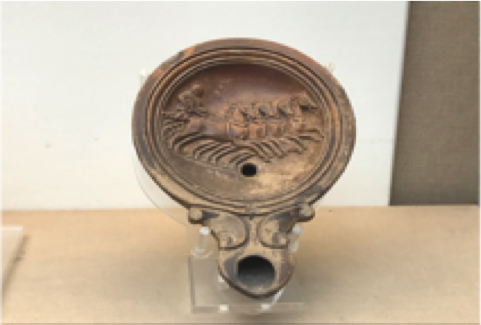 |
 |
|
An oil lamp showing an image of a
charioteer
|
A token from the Ashmolean museum
depicting a charioteer.
|
 |
|
A wax seal, from the British Museum,
depicting a horse and palm branch.
|
Chariot racing was perhaps the most popular sport in the Roman world, as can be seen when Lucian recounts that the “craze for horses is really great, you know, and men with a name for earnestness have caught it in great numbers” (Nigrinus, 29). In Rome, the event was held in the Circus Maximus, which could seat up to 150,000 people, and thus at any given time contain a sixth of the population. Horses feature commonly on tokens in many guises, such showing their domestic function of carrying heavy objects, but also, as seen above, in a more competitive atmosphere of the races. Since such imagery is seen elsewhere, such as an oil lamp, it clearly indicates tokens had a role within the stadia, possibly as entrance tickets for the races. Moreover, some tokens depict horses alongside palm branches. These branches are a symbol of victory, and the very same imagery can be seen on a wax seal from the 1-2nd century AD, also in relation to chariot racing. Thus it could also be suggested that tokens could commemorate a successful day at the races, or have a role in betting. Like today, the Romans would bet on horses, since chariot races involved four different teams, each with their own groups of supporters.
Furthermore, there is also a suggestion that tokens could have had a role in hunting. Hunting had been important in Roman society for centuries, starting as a way to catch food, but later developing into an elite hobby, intended to both train young men for military action, and improve their morality. Some aristocrats had game parks, and there are scenes of the hunt depicted in mosaics, to decorate the domestic space. This indicates how the sport was a popular pastime, and even a status symbol. Some images on tokens are very similar to this mosaic, showing a hunter closing in on a boar, holding his spear aloft. Perhaps therefore, tokens were invites to a hunt, or a commemorative item. This particular image however, could also have come from the games, as boars were hunted both privately, and as part of the entertainment provided in the amphitheatre.
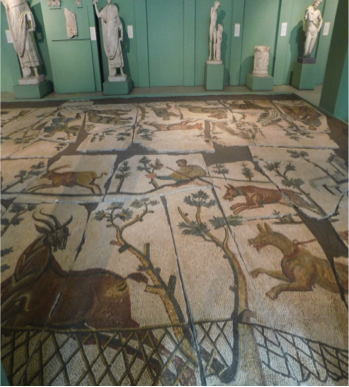 |
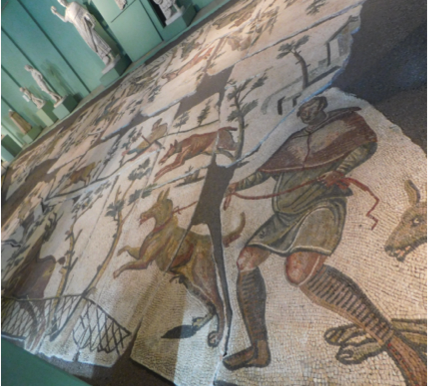 |
| Two scenes from a mosaic which depicts a wild hunt. |
Additionally, the games are perhaps one of the most famous aspects of the Roman world for the modern reader, and their importance can be seen in the way Juvenal suggests all the Roman people wanted was “bread and circuses” (Satires, 10). Alongside the famous gladiators, animal shows, called venationes, were commonly held. During these events, great effort was made to make the colosseum appear like a hunting ground, including the use of scenery, and many animals are recorded as being used, such as big cats, elephants, bears, and herbivores such as boar, deer, and more exotically, zebras. These unfortunate creatures were transported from the conquered provinces, as symbols of Roman superiority over nature, and their empire. Importantly, all these animals can be seen on tokens. Although many tokens are unclear because of the damage they have incurred over the centuries, lions and elephants are instantly recognisable because of their manes and tusks respectively. Elephants were important symbols during the games, and were even depicted coinage. Their size and strength made them signs of the emperor’s might and generosity, thus they became a representation of the games as a whole. Furthermore, lions were commonly used both in the games and images across the Roman world, such as mosaics, where they are seen as vicious, and fearful creatures, who would have been impressive in the amphitheatre. Both these animals therefore hint at the role tokens could have had in the games, again perhaps as a commemorative item.
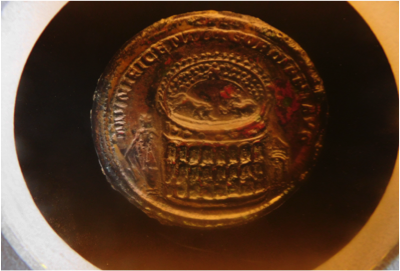 |
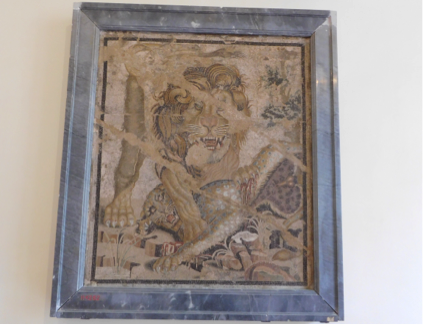 |
|
A Roman coin featuring an elephant fighting a big cat in the amphitheatre.
|
A mosaic from Pompeii depicting a lion. |
Perhaps the most illuminating piece of information about the use of tokens in relation to the games comes from literature. Martial tells us “now a large number of tessera allots animals which were watched…now a bird rejoices to fall into a safe lap and is assigned owners by lottery in its absence, to save it from being ripped apart” (Epigrams, 8.78.7-12). This seems to suggest that the meat of the animals would have been distributed to the crowds after the shows, using the tessera, the Latin word for tokens, for ease. Indeed there is no evidence of storage space, or the burial of the dead animals in the colosseum, and while this is disgusting to the modern reader, this practice would have provided a way to both please the populous, and deal with waste. This therefore seems like their most likely use, especially since some tokens do depict birds, as mentioned in the extract.
There are certainly many different examples of animal tokens, and many different possible uses for them, including both practical and commemorative functions. They show how tokens could be closely connected to the world of entertainment, as well as the variety of animals in Roman society.
 |
This month's piece was written by Rebecca Rolfe, a Classical Civilisation with Study in Europe student currently on her year abroad in Italy. She is interested in the importance of iconography in Roman artwork, and the symbolism of images on Roman coins. Over the summer of 2017 Becky conducted research on the animal tokens of Rome with the support of Warwick's Undergraduate Research Support Scheme. As part of her research she translated a segment of Rostovtzeff's Latin catalogue of Roman tokens related to spectacles into English. If you want to learn more about these tokens, the translation is available here!
Bibliography:
Anderson, John Kinloch (1985), Hunting in the Ancient World (Berkley, University of California Press).
Bell, Sinclair and Willekes, Carolyn (2014) ‘Horse Racing and Chariot Racing’, in The Oxford Handbook of Animals in Classical Thought and Life, ed Gordon Lindsay Campbell (Oxford, Oxford University Press) 478-491.
Harrison, George (2001), ‘Martial on Sportula and the Saturnalia’, in Mouseion: Journal of the Classical Association of Canada, Vol 1, No. 3, pages 295-312.
Jennison, George (1937), Animals for Show and Pleasure in Ancient Rome (Manchester, University of Manchester Press).
Kyle, Donald (2007), Sport and Spectacle in the Ancient World (Oxford, Blackwell).
MacKinnon, Michael (2014) ‘Hunting’, in The Oxford Handbook of Animals in Classical Thought and Life, ed Gordon Lindsay Campbell (Oxford,Oxford University Press) 203-216.
Meijer, Fik (2010), Chariot Racing in the Roman Empire (Baltimore, John Hopkins University Press).
Scullard, Howard Hayes (1974), The Elephant in the Greek and Roman World (London, Thames and Hudson).
Shelton, Jo-Ann (2014) ‘Spectacles of Animal Abuse’, in The Oxford Handbook of Animals in Classical Thought and Life, ed Gordon Lindsay Campbell (Oxford, Oxford University Press) 461-478.
Toynbee, Jocelyn (1973), Animals in Roman Life and Art (London, Thames and Hudson).
April 01, 2017
Antony's retaliation to Augustan propaganda
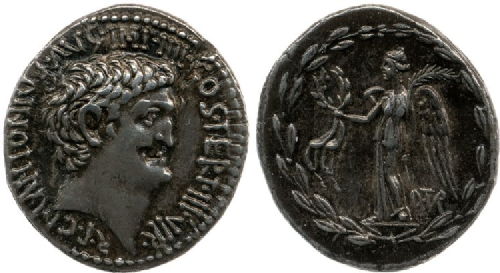 |
|
Denarius of Mark Antony (RRC 545/1), 31 BC
Obverse: Bare head of Mark Antony, M·ANTONIVS·AVG·IMP·IIII·
COS·TERT·III·VIR·R·P·C
Reverse: Victory standing left holding wreath tied with fillet in right hand
and palm-branch over left shoulder with left hand. Laurel-wreath as border. D·TVR
|
The battle of Actium in 31BC was the most important event in Augustus’ campaign of justification after assuming more power and influence than any other individual. This battle was the climactic clash between Augustus and Antony in 31 BC, in which the victor would gain control of the Roman world. We may be tempted to think of this battle as a symbol of the triumph of a military despotism, but Augustus used a multitude of methods to convince the Romans otherwise. But Augustus himself unwittingly confirmed his misdoings: the Res Gestae opens with brazen assertions of high treason and a cliché-ridden defamation of a consul of the republic. Augustus was therefore forced to cleverly exaggerate the extent of his victory by following a systematic denigration of Antony. The reason for Augustus’ campaign against his enemies was to debase their character and make their deposition seem as far from a power struggle as possible, hoping instead that he would appear as the bulwark against immoral and dangerous individuals for the Romans. This was a countermeasure to seeming as if he was declaring war on Antony for his own private interests. The Antony of Cicero, associated with prostitutes and corteges of actresses and often drunk is the foundation of Augustus’ Antony. This disparagement of Antony was important in denying monarchical claims to power, it characterised Antony as unsuitable for power and dangerous to the republic, which forced Augustus to champion the defence of the republic. This was similar to the character assassination of Sextus Pompey. Augustus branded Sextus as a pirate, rather than admit to engaging in civil war: ‘I pacified the sea from pirates ’ (Res Gestae 25), preferring to claim he acted out of compulsion and loyalty to the state.
Augustus confronted Rome with ‘the will which Antonius had left in Rome, naming his children by Cleopatra among his heirs, opened and read before the people ’ (Suetonius, Life of Augustus, 17). It allowed Augustus to reassert this status as the champion of the Roman people, however it is exceptionally pertinent to remember that Augustus’ extortion of the vestal virgins in procuring this will was something wholly illegal. Augustus juxtaposed himself and Antony through his mausoleum. Though completed in 28BC, it was important in the propaganda war: Augustus’ monumental tomb offered a demonstrative and public contrast to Antony’s alleged desires to be buried in Alexandria. This may have encouraged the Romans, in their indignation, to believe that the other reports in circulation were also true: if Antony should succeed, he would bestow their city upon Cleopatra and transfer the seat of power to Egypt.
Despite Augustus’ best efforts to brand Antony as traitor, Antony’s denarius of 31 BC shows a different story. The coin depicts Antony with a full list of titles, advertising his role as augur (AVG), imperator for the fourth time (IMP IIII), consul for the third time (COS TERT) and triumvir (III·VIR·R·P·C). This was an undeniable assertion that he was far from a foreign enemy, suggesting instead that Augustus’ behaviour was exceptionally anti-republican (to openly share such enmity with a fellow Roman would be a source of revilement). Antony’s use of a denarius is wily; it reaffirmed his legitimacy as a member of the Roman elite while suggesting Augustus’ lust for power as a man willing to enter into civil war for supremacy. The reverse features Victory standing left, a blatant reminder that it would be Victory who supported Antony. The denarius openly deconstructed Augustus’ campaign of invective and propaganda; it was a poignant reminder to the people of Rome that Antony was not the Eastern enemy he was made out to be.
 |
This month's coin entry was written by Alfred Wrigley. Alfred is a third year Ancient History and Classical Archaeology student with a great research interest in Julio - Claudian numismatics
Image copyright Trustees of the British Museum (1855, 1118.3)
November 01, 2016
Reunifying the empire: Aurelius and Sol Invictus.
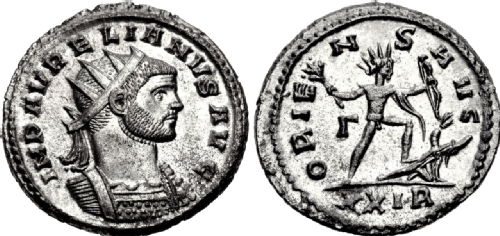 |
|
|
Antoninianus. RIC V 64
Obverse: IMP AVRELIANVS AVG. Radiate and cuirassed bust of Aurelian facing right.
Reverse: ORIENS AVG. Sol Invictus holding laurel-branch and bow, treading on fallen enemy.
Γ (mintmark) behind Sol, XXIR in exergue.
|
This is an antoninianus (a denomination theoretically worth 2 denarii) of Aurelian, who was emperor of the Roman Empire AD 270-275. It is worthy of study because of the sheer amount of information we can draw, in terms of military, economic and religious history, from this one type of coin.
We see that Aurelian wishes to be seen as a military figure; this is conveyed through his depiction on the obverse in armour and on the reverse the depiction of Sol treading down on an enemy. To properly understand the meaning of this imagery we have to consider the state of the empire as Aurelian comes to power. The empire has fragmented with Queen Zenobia ruling in the east out of Palmyra and Tetricus declared emperor in the West as part of the Gallic Empire (see map below). In AD 272 Queen Zenobia, who was in control of Egypt, cut off the grain supply to Rome. Aurelian responded by taking his army east and defeating her, regaining control over the eastern portion of the empire. In AD 273 he gained the title Restitutor Orientis (Restorer of the East) which he placed on his coinage (RIC V 140). In 274 after returning to Rome, Aurelian marched West, defeating Tetricus at the Battle of Chalons, reunifying the empire and gaining the title Restitutor Orbis (Restorer of the World). This coin type has a date range of AD 270-275. At the beginning of his rule, imagery of victory might have been associated by the average Roman citizen with Aurelian’s victory against the barbarians at Alemanni in northern Italy. In AD 275 this type of imagery might have been interpreted as representative of the victories that had reunified the empire (Zosimus 1.25). In this case the legend on the coin, ORIENS AVG, refers to the east, and suggests that the intended message was Aurelian’s successes in this region.
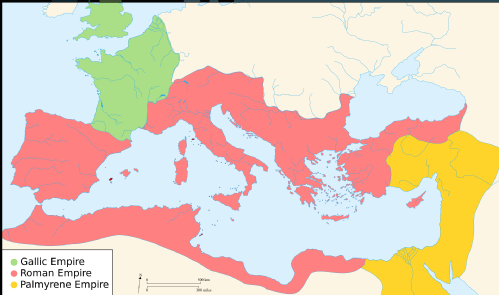 |
|
Map of the Roman World in AD 271
|
The economic history this coin reveals is also interesting. The radiate crown on Aurelian’s head is there to indicate that this is an antoninianus rather than a denarius. This denomination was introduced in AD 215 to combat a lack of silver. Its introduction may have helped generate the rampant inflation that led to the silver purity of the antoninianus crashing to just 3.79% by AD 270. This specific coin is an example of what followed: Aurelian reformed the coinage, motivated by a desire to restore some confidence in the currency and to curb inflation. We know this because the legend in the exergue of this coin reads ‘XXI’. This was a guarantee that 20 of these coins could be exchanged for one argenteus of pure silver (20:1, XX:I). The coins were promised to have 5% silver, although if we actually drilled into the coin we would probably only find a purity of 4.1%, due to surface leeching of silver over the years. Another part of Aurelian’s coinage reform was increasing the physical weight of the coinage; before the reform between 86-98 coins were made from each pound of billion (debased silver), following the reform this was lowered to a range of 81-90, giving a theoretical weight to each coin of 4.03g.
The religious history we can gain from this coin is the changed role of Sol in this period. No longer is he merely pictured in his traditional form with the whip or globe standing emollient. Now he appears with a traditional whip but also a bow, treading down the enemy, invoking the new cult of Sol Invictus in action, even if the legend is limited to ORIENS AVG (Rising (Sun) of the emperor). Coins were also produced with the legend SOLI INVICTO (Sol the Unconquerable) (RIC V 154). This represents a change in this period in the Rome pantheon, with the rise of Sol Invictus to a position of prominence. Aurelian’s victories are associated with Sol rather than Jupiter. There is scholarly debate over the exact nature of this cult, with the traditional view being Aurelian imported an eastern deity, but recent scholarship has challenged this, suggesting that the cult may have developed out of the traditional Graeco-Roman god Sol. The additional evidence for Sol Invictus taking greater prominence is Aurelian’s new temple built to Sol Invictus in Rome and the setting up of a new priestly college, pontifices dei solis. A final thought on the influence of Sol Invictus on our world today is his holy day, dies Invictus Natalis. This was placed on the 25th December and while it was an important day anyway within the Roman calendar, being the winter solstice, one is left to wonder whether the particular rise in the importance of that date due to Sol Invictus influenced early Christians in their decision to adopt this date as the birth date of Christ.
 |
This month's coin was written by William Tait, Third year undergraduate in Ancient History and Classical Archaeology with a particular interest in the 3rd century AD and how coinage can improve our understanding of this period.'
Bibliography:
Drinkwater, J.F. (1987), The Gallic Empire: Separatism and continuity in the north-western provinces of the Roman Empire, Franz Steiner Verlag, Stuttgart.
Halsberghe, G. (1972), The cult of Sol Invictus, Leiden: Brill.
Hijmans, S. E. (1996), The Sun which did not rise in the East; the Cult of Sol Invictus in the Light of Non-Literary Evidence. Babesch 71: 115-150.
Southern, P. (2015) The Roman Empire from Severus to Constantine, Routledge, London.
Watson, A. (1999), Aurelian and Third Century, Routledge, London and New York.
Zosimus, New History, trans. T. Chaplin & W. Green (London: Green and Chaplin 1814)
Coin image reproduced courtesy of Classical Numismatic Group Inc., (Auction 88, lot 1399) (www.cngcoins.com)
 Clare Rowan
Clare Rowan

 Please wait - comments are loading
Please wait - comments are loading

 Loading…
Loading…

